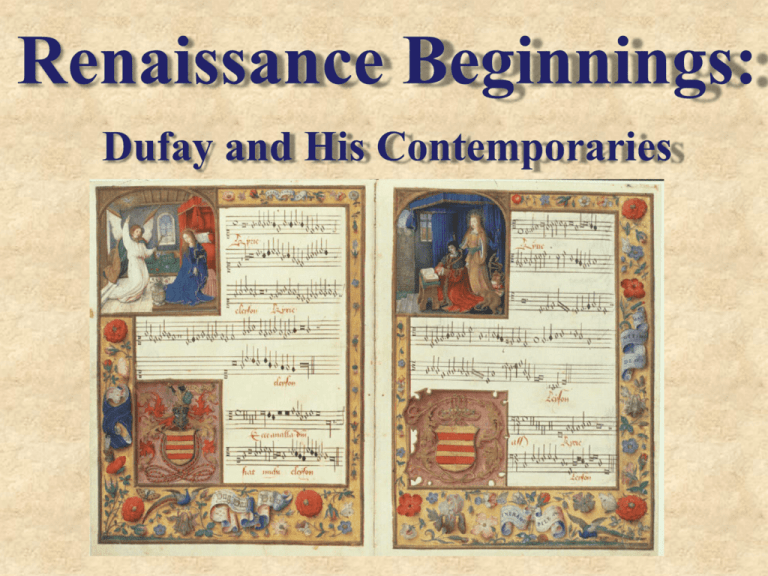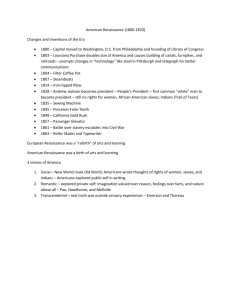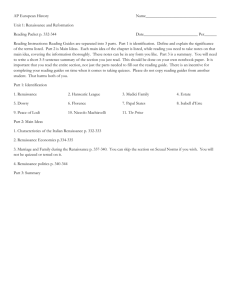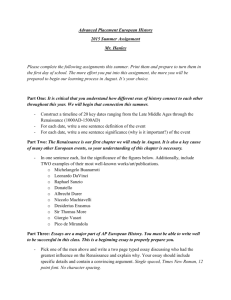Powerpoint
advertisement

. . . there does not exist a single piece of music not composed within the last forty years regarded by the learned as worth hearing . . . Johannes Tinctoris, 1477 Quirky, nervous rhythms (syncopation) High level of dissonance Mathematically derived isorhythm John Dunstable: How Beautiful You Are (Quam pulchra es) How beautiful and fair you are, my beloved, Most sweet are your delights. Your stature is like a palm-tree, And your breasts are like fruit. I. Renaissance Music: Cultural Context A. Dates for the Renaissance: 1475-1600 or 1400-1600? Idiot! He is so wrong! I. Renaissance Music: Cultural Context A. Dates for the Renaissance: 1400-1600 or 1475-1600? I. Renaissance Music: Cultural Context A. Dates for the Renaissance: 1400-1600 or 1475-1600? B. The “Problem” of Rebirth for Music No models of music from ancient Greece or Rome C. The Geography of Renaissance Music When am I coming back? Dunstable, Dufay, Binchois, Ockeghem, Busnois, Compère, Obrech I. Renaissance Music: Cultural Context A. Dates for the Renaissance: 1400-1600 or 1475-1600? B. The “Problem” of Rebirth for Music C. The Geography of the Renaissance Age of the Burgundians or Netherlanders D. The Rise of Humanism Humanism vs. Scholasticism •Decreasing reliance on authority (chant or pre-existing music) •Composer not mere conduit, but creator •What sounds good matters (counterexample = Machaut’s “Quant en moy, or “My End is My Beginning”) II. Musical Characteristics: Renaissance A. Method of Composing: Simultaneous, not Successive B. Preferred Intervals (“sweet” 3rds” not “hollow” 5ths) & Dissonance Treatment (used carefully, sparingly) C. Voices become more nearly equal in importance D. Predominant Texture: Imitative Polyphony (melodies presented in imitation) E. Secondary Texture: Block Homophony F. The Sound Ideal: a cappella G. Musical Genres of the Renaissance III. Guillaume Dufay A. Other Early Renaissance Composers (1400-1475) Gilles Binchois, John Dunstable, Johannes Ockeghem B. Dufay’s Bio. & the Typical Renaissance Career Born in North (i.e., Burgundy or Netherlands) Career includes time in Italy Major composers tend to hold posts at secular courts IV. Dufay’s Veni Creator Spiritus A. Based on a Chant B. Hymns use strophic form: same music for each verse C. Alternatim setting D. 4 line poem= 4 phrases in chant E. Dufay’s verses = three voices F. Cadences mark 4 phrases G. Paraphrase Technique Dufay’s Veni Creator Spiritus (hymn): Paraphrase Technique Chant Top voice of Dufay’s setting Paraphrase Technique: 1. Chant in top voice (where most audible) 2. Rhythmicized, but retains audible relationship to chant 3. Notes of chant rewritten or “paraphrased” V. New and Old in Dufay’s Veni Creator Spiritus A. New or Renaissance Features 1. “Sweet” sounds of 3rds 2. Voices move at equal speed 3. Chant altered via paraphrase B. Old or Medieval Features 1. syncopation 2. Open 5ths still predominate at cadences 3. Triple meter (perfection) 4. Still based on Gregorian chant







